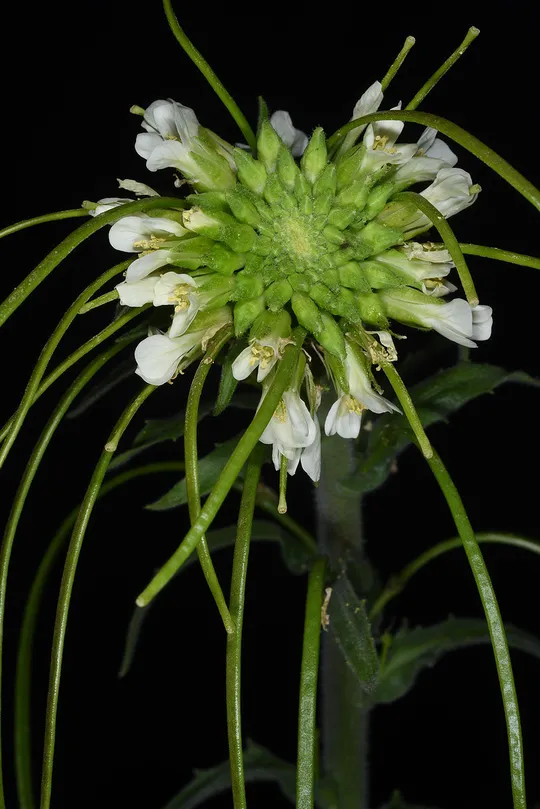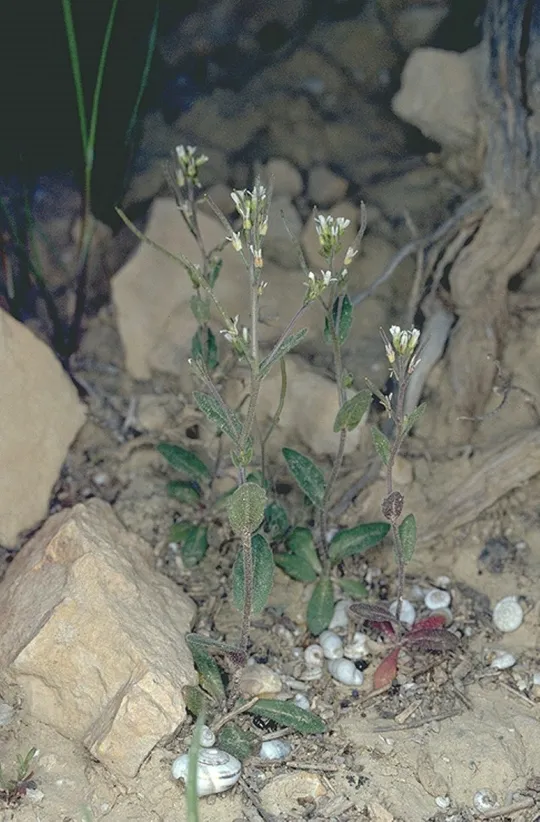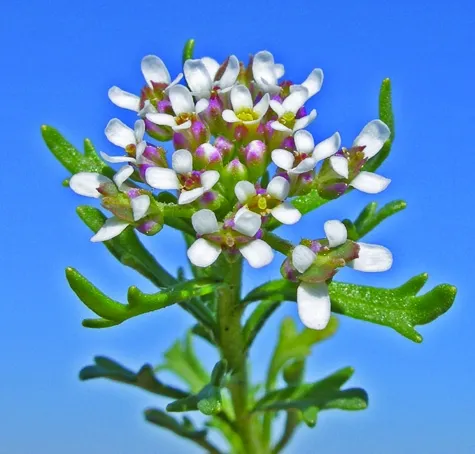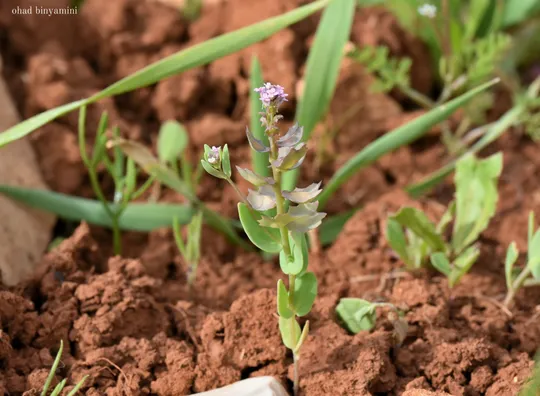Alpine Rock Cress
Arabis alpina
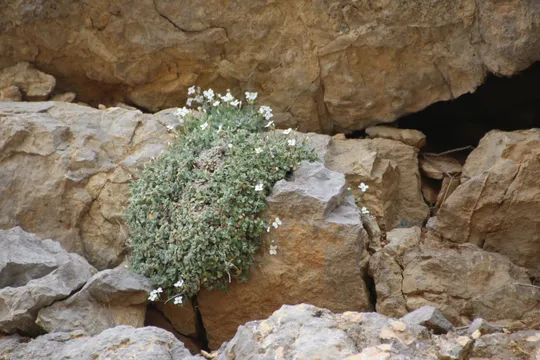
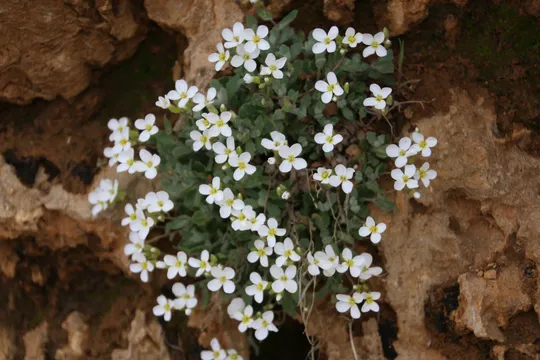
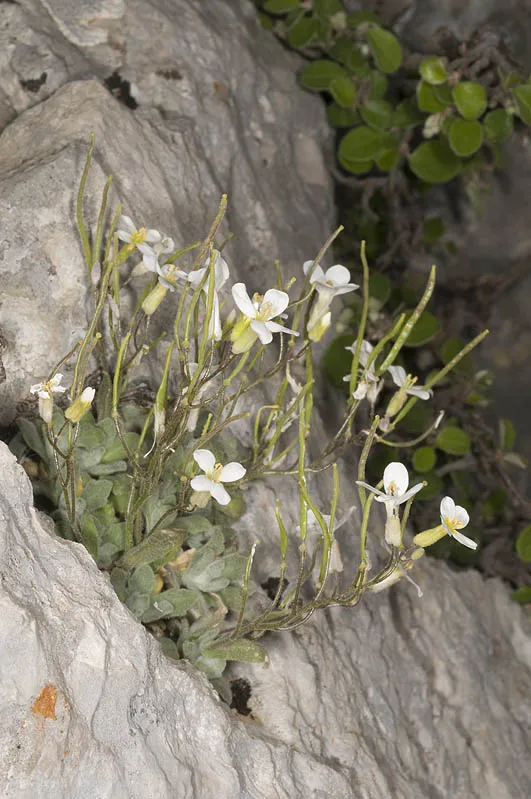
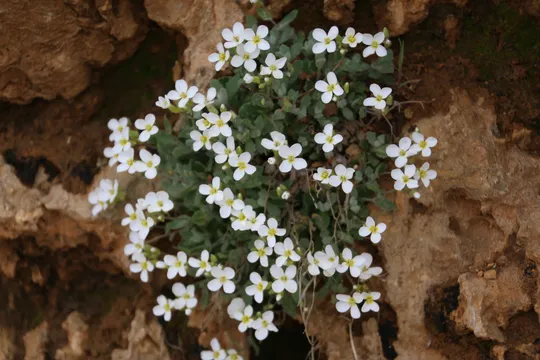
Arabis alpina ssp.caucasica is a mostly herbaceous dwarf shrub, shaped like a dense whitish cushion, 10-23 cm across that grows only on cliffs. The slender branches have woody bases, twine among the rocks, and bear oval leaves with stellar white hairs. The lower leaves have petioles and form a rosette and the other leaves clasp the stem. Abundant white flowers completely covers the foliage. Cylindrical calyx, 5-7 mm long, with a bi-saccate base. The flower is nail-like, with a long tube and ends in four pure white rotate corolla blades at right angles to the calyx. The white flower is 10-16 mm across with a yellow spot at its center. The fruit is a thin pod with slight constrictions between the seeds, 2-3 cm long, borne on a narrower pedicel. The seeds have short wings. The plant blooms from mid-March to late April. On Mount Hermon the flowering continues in May as well and is particularly abundant, which is characteristic of alpine plants.
Arabis alpina ssp. caucasica grows only in the eastern Upper Galilee west of the Jordan River, in three adjacent sites: on the northern slope of Mount Evyatar at an altitude of 650-800 m, on the Mount Almon cliff at an altitude
of 600 m and on the Mount Rehan cliff on the slope to Dishon Stream at an
altitude of 640 m. In Israel, the species was first collected by Aaronson in 1906 and published later
(Aaronsohn, 1940). Aaronson noted in
his diary that on the Wadi Shababik cliffs (=Nahal Wadi Hatsor) there
are meadows of Arabis alpina caucasica. In 1966, Zohary included
it in the Flora Palaestina according to Aaronson's herbarium, and noted
that it had not been collected since Aaronson’s time. The
population was located again on the Mount Evyatar cliff in 1973 by Gideon Ne’eman, and was reviewed in detail (Cohen and
Schmida, 1991). The survey identified two additional sites on the cliffs dropping towards the Dishon Stream.
Rock crevices and soil pockets on eroded limestone cliffs, in shady, treeless sites. In the mountainous and alpine zone of the Hermon it dominates on north-facing cliffs at altitudes of 1300-2300 m.
The genus Arabis includes 180 species found in temperate areas of
Old and New World. Arabis alpina caucasica belongs to a group of closely related
species, growing on mountainous and alpine cliffs from Spain throughout Europe
and western Asia to the Himalayas and Central Asia. Distinguishing
between the species in the group is very difficult, and they can be viewed
as a chain of vicarious subspecies that grow in the same habitat,
and replace each other geographically while gradually changing morphologically.
A. a. caucasica is a single species in Israel that represents a
group of alpine plants. The species in the group grow in rocky alpine-montane
regions, from Western Europe to the Himalayas
and the Tian Shan mountains.
Arabis alpina caucasica is
in danger of extinction because it
grows in only three
sites in a single section, in
a single region. On the other hand, the sites are not sensitive to development and not
easily accessible. They are distant from human habitations and are
difficult to access. Nevertheless,
cliff habitats are stable and usually not disturbed
·
The
populations on Mount Evyatar and
Mount Almon are included in nature reserves. The populations in the Dishon
Stream (Mount Rehan), although close to the
reserve, are
located outside it.
·
The
Mount Almon population consists of 30 plants (1991); the populations of Mount Rehan numbers 500 and the population of Mount Evyatar numbers 970. Most of
the plants produce fruits and seeds.
·
Attractiveness
– the plant is conspicuous and beautiful
when in bloom, but does not attract pickers.
·
Fragmentation
– all the sites are in one section, and the maximal distance between
sites is 4 km.
Arabis alpina caucasica
populations should be monitored in the
spring and at the beginning of winter. At least two of the
sites, Mount Almon and Mount Rehan, need special care to maintain the populations, which are small. Efforts should be made to include the Mount
Rehan site in the nearby Dishon Stream
Nature Reserve.
Arabis alpina caucasica
grows in the Mediterranean and
Irano-Turanian regions: from France and Italy (Sicily)
to the west through the Balkans (Bulgaria, Yugoslavia, Albania,
Greece, Crete), Turkey, the Caucasus, Syria-Lebanon. In North Africa, it grows in the Atlas Mountains in Algeria and Morocco, and in the Canary Islands. In Asia, it grows in Iran, Iraq, and
Afghanistan and in
Central Asia – Turkmenistan, Pamir and Tian Shan. The species was also noted from Upper Egypt (questionable) and from the mountains of
East Africa.
Arabis alpina caucasica is a cliff
plant, which is endangered because it grows at only three sites, all of them in a single section of the eastern Upper Galilee. This is the only alpine species in western Israel. These populations are distant from the
plant’s main global
range and are located
on the southern border of
its distribution area. This is the only area south of Mount Hermon where the species grows and where it has descended
to such low altitudes. Although the sites are not very sensitive to development, the size of the populations is small and they should
be preserved and monitored.
אהרונסון, א. 1940. צמח מערב הירדן. ערכו: ה. אופנהיימר ומ. אבן-ארי. קרן אהרונסון – זכרון יעקב. 66-67, 233.
Cohen, O. and Shmida, A. 1991. Botanical notes. Israel Land and Nature. Vol. 17/1:25.
Cullen, J. 1965. "Materials for a Flora of Turkey: X". Notes R.B.G. Edinb. 26:188–189.
Current Occupancy Map
| 1000 squre meter pixel | 5000 squre meter pixel | 10000 squre meter pixel | |
|---|---|---|---|
| number of observations | 0 | 0 | 0 |
| in total pixels | 0 | 0 | 0 |
| Family | Brassicaceae |
| Classification | On the near threatened species list |
| Ecosystem | Tragacanthic, Mountainous semi-steppe forest |
| Chorotype | Mediterranean and Irano – Turanian and South Euro– Siberian |
| Conservation Site | Mount Evyatar, Yif'at ridge on the Hermon |
| Rarity |
1
4
6
|
|---|---|
| Vulnerability |
0
0
4
|
| Attractiveness |
0
0
4
|
| Endemism |
0
0
4
|
| Red number |
1
2.6
10
|
| Peripherality | N |
| IUCN category | DD EW EX LC CR EN VU NT |
| Threat Definition according to the red book | Near threatened |
 Based on:
Based on:
